Honor Award
Redrawing Equity
Herimar Meneses, Student Affiliate ASLA; Rafael Vásquez, Student Affiliate ASLA; Fabiola Meignen, Student Affiliate ASLA and Santiago Rizo, Student Affiliate ASLA, Universidad Simón BolÍvar
Faculty Advisor: María Mercedes Hernández
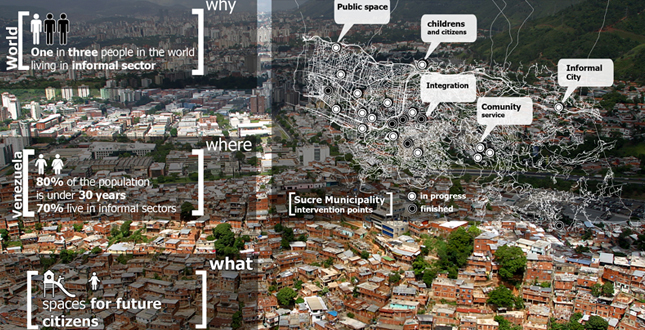
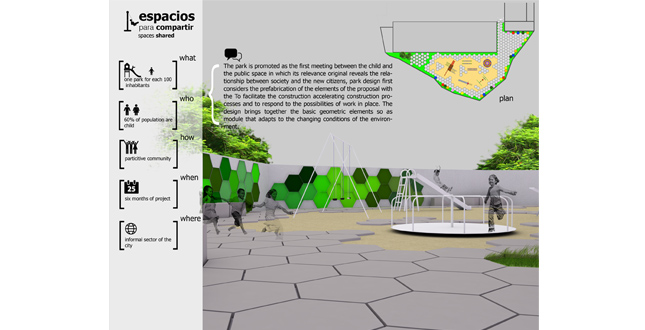 Close Me!
Close Me!Espacios Para Compartir (Shared Spaces). The park is promoted as the first meeting between the child and the public space in which its relevance original reveals the relationship between society and the new citizens, park design first considers the prefabrication of the elements of the proposal with the to facilitate the construction accelerating construction processes and to respond to the possibilities of work in place. The design brings together the basic geometric elements so as module that adapts to the changing conditions of the environment.
Download Hi-Res ImagePhoto:
Photo 2 of 14
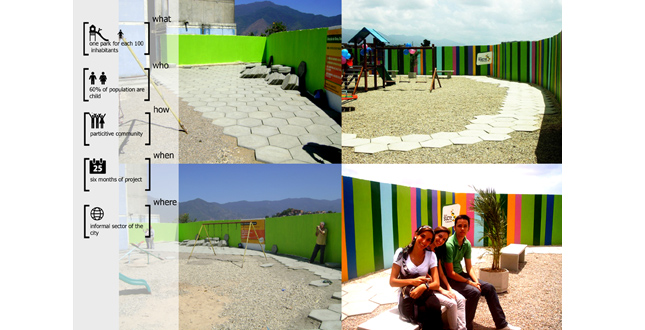 Close Me!
Close Me!Integration Parks—La Dolorita. Building and inauguration process.
Download Hi-Res ImagePhoto:
Photo 3 of 14
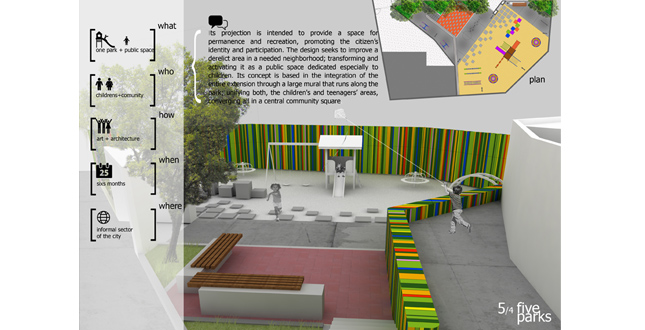 Close Me!
Close Me!Integration Parks. Its projection is intended to provide a space for permanence and recreation, promoting the citizen’s identity and participation. The design seeks to improve a derelict area in a needed neighborhood; transforming and activating it as a public space dedicated especially to children. Its concept is based in the integration of the entire extension through a large mural that runs along the park; unifying both, the children’s and teenagers’ area, converging all in a central community square.
Download Hi-Res ImagePhoto:
Photo 4 of 14
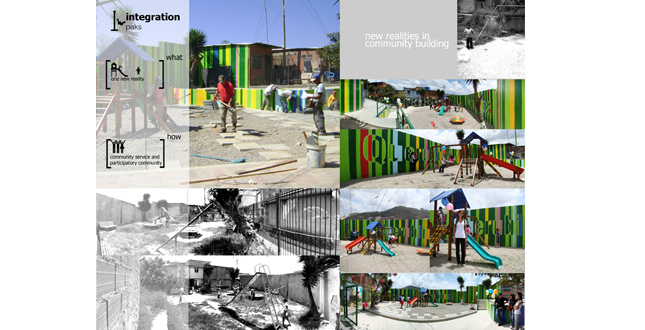
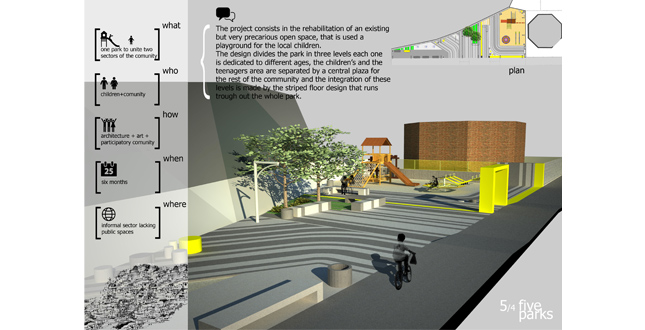 Close Me!
Close Me!Integration Parks. The project consists in the rehabilitation of an existing but very precarious open space, that is used a playground for the local children. The design divides the park in three levels each one is dedicated to different ages, the children’s and the teenagers area are separated by a central plaza for the rest of the community and the integration of these levels is made by the striped floor design that runs through out the whole park.
Download Hi-Res ImagePhoto:
Photo 6 of 14
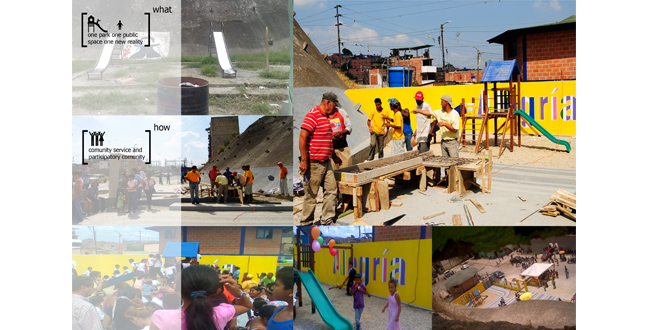
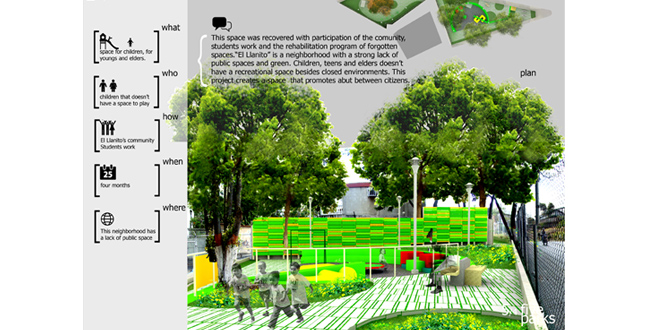 Close Me!
Close Me!Integration Parks — El Llantito Park. This space was recovered with participation of the community, students work and the rehabilitation program of forgotten spaces. “El Llanito” is a neighborhood with a strong lack of public spaces and green. Children, teens and elders doesn’t have a recreational space beside closed environments. This project creates a space that promotes abut between citizens.
Download Hi-Res ImagePhoto:
Photo 8 of 14
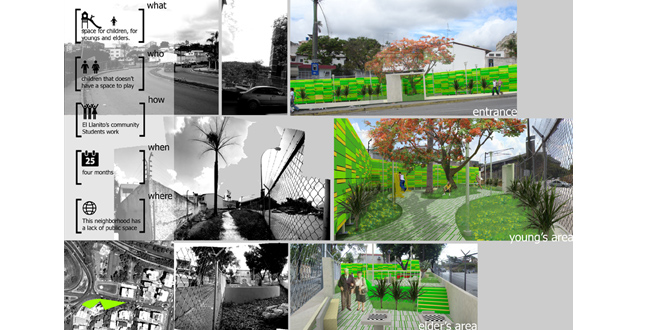 Close Me!
Close Me!Integration Parks — El Llantito Park. Projecting new realities.
Download Hi-Res ImagePhoto:
Photo 9 of 14
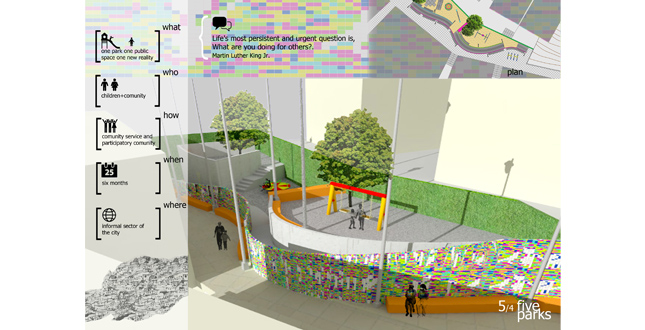 Close Me!
Close Me!Integration Parks. Life’s most persistent and urgent questions is, what are you doing for others?—Martin Luther King Jr.
Download Hi-Res ImagePhoto:
Photo 10 of 14
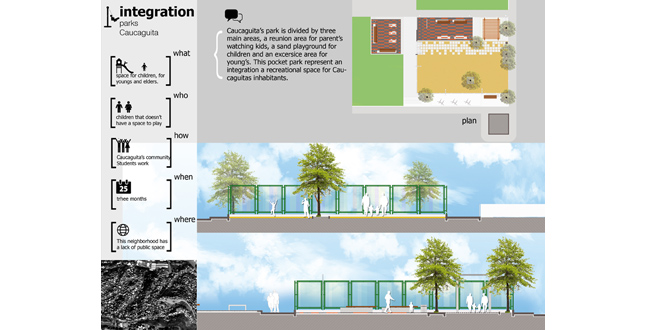 Close Me!
Close Me!Integration Parks—Caucaguita. Caucaguita’s park is divided by three main areas, a reunion area for parent’s watching kids, and a sand playground for children and an exercise area for young’s. This pocket park represents an integration a recreational space for Caucaguitas inhabitants.
Download Hi-Res ImagePhoto:
Photo 11 of 14
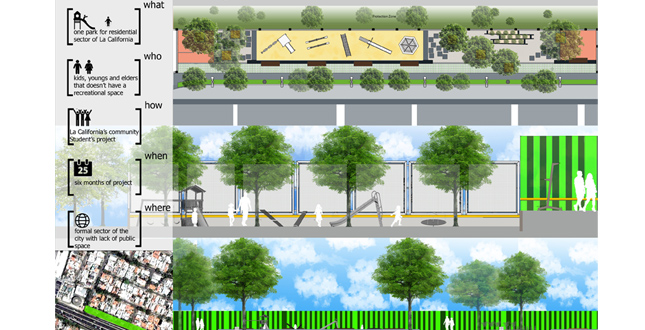 Close Me!
Close Me!Integration Parks—La California. The Park takes advantage of a residual space between the boundary of the neighborhood and the freeway. The green strip is converted into a public space for residents in the area of La California, which previously had no recreational space. Every available spacer in the strip lengthwise. Spaces were proposed for walking for the elderly, to chat areas, areas of playground and fitness area.
Download Hi-Res ImagePhoto:
Photo 12 of 14
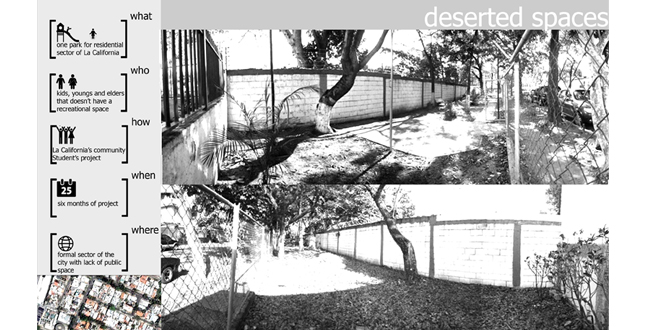
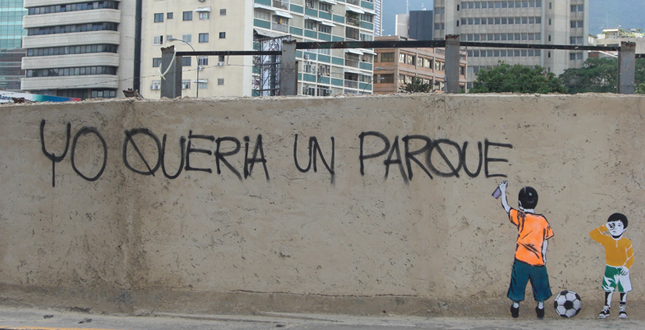 Close Me!
Close Me!Yo Queria un Parque (I wanted a park) real picture, Caracas, Venezuela
Download Hi-Res ImagePhoto:
Photo 14 of 14
Project Statement
More tangible conditions of the city of Caracas, is the vast difference that lives and perceives between formal and informal city. Thinking about integrating both seem almost intractable problem, so we propose to achieve conditions that approximate both realities through the public space, including parks as the place of representation of equity, covering the integration of art and Landscape quality economically feasible with a response to the needs of communities.
Project Narrative
In Caracas, more than 80% of the population lives in areas of origin and informal occupation, called "Barrios". These are neighborhoods where informality is the rule, such as the lack of basic services. These “Barrios” are implanted in abrupt topographies that makes very difficult to connect them with the rest of the city and are located in zones intervened in a way that increase the risk in case of natural events. This neighborhoods are characterized for a really high crime and dropout rates and it is in itself a different way of making a city where the references of public and private space are converted, transformed in pursuit of their own needs. Thanks to this the large scale of formal town planning becomes outdated and the ways of analysis and study are not effective anymore. Because of the lack of roads, the public stairs becomes the street, and is considered as the great public space in the “Barrios”, not only has the function of mobility and connection but represent a new way to occupy this space, where Duality is a standard and deficiency a condition. The way of occupation and citizen outreach in the Barrios generates a significant social links with community ties that achieves set standards of living and behavior not known in the field of what theorists call the formal city, as well as the participation of members community rather than a precondition is a necessity, because of this depends that any action of any kind could be accepted and appropriated for future users.
Caracas is divided into five municipalities; one of them is the Sucre municipality which is formed for five parishes, four of them concentrated near to 2000 “Barrios”, including the José Félix Ribas, considered the biggest “Barrio” in Latin America, with a population of approximately 120,000 inhabitants in an area of 96 hectares. In Sucre municipality there are only seven parks, considering its population to the number of parks gives a ratio of 33 072 children and adolescents for each park, reflecting a critical shortage of these spaces, especially, if they also serve other municipalities of the city. Caracas has 1.2 m2 of green areas per capita. The WHO sets as optimal 15 m2 of green areas per capita or at least 10 m2. The population density of the municipality is 3831 people per km2 and the group of children and adolescents represent 57% of the total population. This lack of public spaces promoted a vision of interventions focused in generation of meeting places, focusing on the largest population living in the “Barrios” in Caracas, which are children and adolescents. These spaces would not only recreational in nature unless they can become trainers of new citizenship, and thus start drawing spaces of equity needed to reconcile the fact of making city and its inhabitants.
Landscape architecture beyond building new realities is the change in the conditions of the landscape looking for the not materialized element that is perception. Thus, the landscape is a catalyst for the perception of space and a factor in the quality of life of the most important goal in the architecture as it is the Human being. Thinking in the Human being it wants to make tangible the influence of the landscape, so we consider the man and the landscape will be the focus of this work, developed in a place where the lack of public spaces is the norm.
As a main elements of landscape architecture in the development of public spaces in communities, it were defined the design guidelines in terms of a sustainability analysis, evaluating physical, economic, environmental and social aspects for the development of the conceptual implementations. From a socio-cultural perception, the park represents the typology to develop as an invitation to social interaction and tolerance directly aimed at the population, promoting respect for communal property and appropriation of space through the sense of belonging, encouraging imagination with the presence of art, architecture and landscape management.
The implementation of the project began not from a master plan but from the need to respond feasible and cover as many “Barrios” as possible. In the process to select the zones, the most important factor was to select areas that harbored as many people as possible and less confrontational to ensure its implementation. The municipality office proposed as a guideline for design, the standardization of furniture and materials depending on the feasibility of maintaining short and long term. As a main rule, was to select high quality materials to respond to the issue of equity actions and their sustainability over time. Among the requirements of the communities were the definitions of the physical security of space and its users, the annexation of children, adolescents and a space for the community. Agreements were signed between the municipality and communities so that they shall become responsible for themselves. As a design constraint was the presence of art through murals, whether made by students or by artists. Because of the scarcity of water in these areas, the use of tree and shrub species was low, but we rely on the color of the wall to enter the green. These patterns of design, furniture and materials shall become the same as those used in the formal city parks.
The generation of these areas aims to create a social impact in these communities, solving in an immediate scale the issues of public space and helping members of these communities to develop in a quality environment and social welfare, where all may participate and be owner’s space. The program aims to achieve and increase the quality of life, creating a social approach and providing recreational services and enjoyment for the whole community of the Municipality of Sucre to develop.
Additional Project Credits
Student collaborations in design and implementation of projects
Amanda Álvarez
Ana María Brito
Cruz Criollo
Gonzalo Romer
Isni Parra
José Ángel Pérez
María De Lourdes Rodríguez
Mary Carmen Rojas
Rebeca Novoa
Collaboration in tutoring projects
Office of Special Programs, Sucre Municipality City Hall





